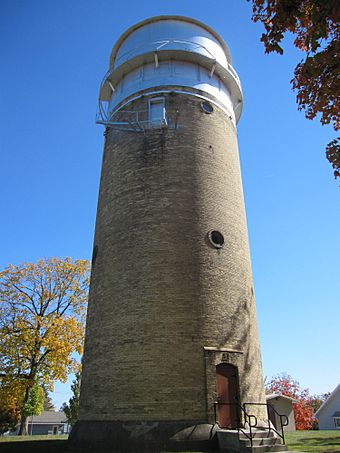Monroe Water Tower facts for kids
Quick facts for kids |
|
|
Monroe Water Tower
|
|
 |
|
| Location | 16th Ave. and 20th St., Monroe, Wisconsin |
|---|---|
| Area | less than one acre |
| Built | 1889 |
| Built by | Monroe Water Works Des Moines Bridge and Iron Co. (tank) |
| NRHP reference No. | 05001290 |
| Added to NRHP | November 15, 2005 |
The Monroe Water Tower is a really old and important building in Monroe, Wisconsin. It was built way back in 1889 to help the town get clean water and fight fires. Today, it's recognized as a special historic place and was added to the National Register of Historic Places in 2005.
Contents
Monroe's Early Days
The first people settled in Monroe in the 1830s. The community quickly grew bigger. Soon, it had a sawmill and other small businesses. In 1858, the railroad came to town. Monroe officially became a village that same year.
By 1870, a fire department was set up. This was a very important public service. But the firefighters didn't have a good way to get water. They mostly used a bucket brigade, which meant passing buckets of water by hand.
In 1888, new technologies arrived. The Monroe Electric Light Company started providing electricity. Homes and street lights could now have electric power. Also, the Wisconsin Telephone Company began offering telephone service.
Building the Water System
In May 1889, a man named W.H. Wheeler from Beloit made an offer. He said he would drill a well and build a "water works" for Monroe. This system would bring water to the town. The city council agreed to the project. They would pay for it if Wheeler would run the system.
Work on the water system began. There were a few problems along the way. So, Wheeler took over the city's part of the deal. In return, he got a 20-year agreement to operate the water system. The project then moved very quickly.
By the end of 1889, the well was drilled. The tall water tower was built. And water pipes were laid all around town. A successful test of the system happened on New Year's Day in 1890.
What the Tower Looks Like
The Monroe Water Tower looks much the same today as it did when it was built. It has a strong foundation made of limestone. Cream-colored brick walls rise 80 feet high. These walls form a round shape that is 28 feet wide.
On top of the brick walls sits a large steel tank. This tank can hold 100,000 gallons of water! When it was first built, the tank was made of wood, but it held the same amount of water. The current steel tank has a steel cone roof.
The brick walls have openings. There are four round openings halfway up. Four more are just below the top of the brick. A doorway at the bottom lets you go inside. There, a wooden staircase winds around an inner brick cylinder. This inner cylinder protects the pipe that brings water from the well. It also helps support the heavy tank above. Another doorway at the top leads to a metal staircase outside. This staircase goes to a catwalk around the metal tank.
Why an Elevated Tank?
Today, a water tower seems like the best idea for a small town. But back in 1889, other ideas were being considered. W.H. Wheeler had to explain why his design was the best.
He said that an elevated tank was better than just using pumps. This is because the high tank would always provide strong water pressure. This pressure was very important for putting out fires.
He also said an elevated tank was better than a standpipe. A standpipe is a tall, narrow tank. Monroe didn't have a high hill to put a standpipe on. Also, if a standpipe's water level dropped, the water pressure would go down.
Wheeler also thought the original wooden tank would be more reliable than metal. He believed it would protect the water better from freezing in winter. The cost of building might have also influenced his choices.
The Tower's Impact and Future
The people of Monroe seemed very happy with their new water system. The local newspaper, The Monroe Sentinel, wrote about the "efficient fire protection." They said it would lower insurance costs and make property values go up. At home, people now had easy access to clean water.
Wheeler first ran the water works himself. But by 1898, he asked the city to take it over. In 1906, the city bought the system for $85,000.
In 1914, the original wooden tank needed to be replaced. The city put in the current steel tank. It was built by the Des Moines Bridge and Iron Company. That steel tank provided water to the community until 1993.
After 1993, the city thought about tearing the tower down. But the Monroe Historical Society worked hard to save it. The tower is important for two main reasons. It is a great example of how small-town water towers were built in the late 1800s. It also shows a big moment when Monroe's government started providing important public services for its citizens.



